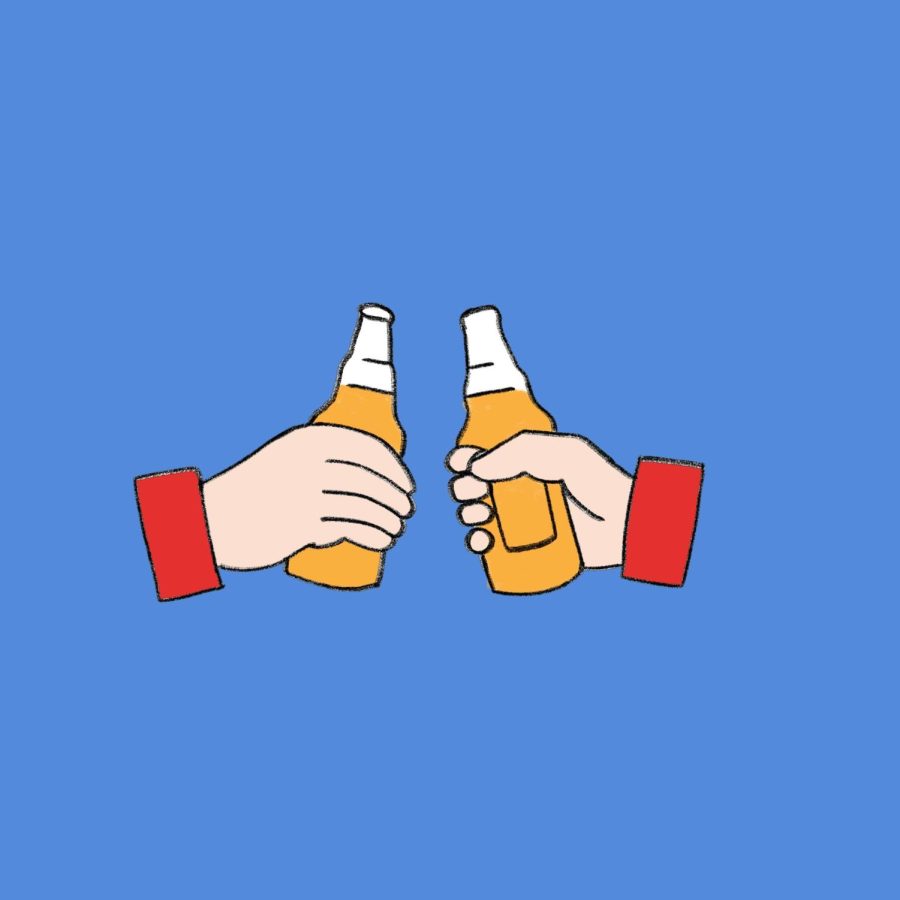Opinion | Lowering the drinking age creates safer environments for college
February 23, 2022
My best friend and I grew up a few streets away from each other, and were practically attached at the hip for 14 years. Even though the two of us grew up similarly, our differences began to show once we left our hometown for college.
Now, I’ve never been one to party or spend my weekends in sweaty frat basements, but my friend used to spend her time partying and drinking a few nights a week. How was she able to do this so easily? Well, she moved 4,000 miles away to London, where the drinking age is 18.
I’ll never forget one of our first weekends apart, when she called me to say how safe she felt in the local pubs, how she knows that college parties don’t have the same safety shield that bars and clubs have.
She told me in the same call that when she returns to the States and has to deal with the strict minimum drinking age, she doesn’t know where she’ll be able to go to feel completely safe — but she knows it definitely won’t be in a frat.
It was upon contemplating this conversation that I added yet another reason why I believe that the minimum drinking age should be lowered. The safety of young adults is being ignored in order to keep this trivial restriction in place.
When you ban something, you give it power. The minimum drinking age set at 21 does little to deter those who wish to drink underage. We have one of the highest minimum drinking ages in the world to keep young adults from drinking, but if people want alcohol, they’ll find a way to get it.
A national survey conducted in 2019 found that 86.3% of respondents between the ages of 18-20 had drunk alcohol at some point in their life, while 26.5% had gone on at least one drinking binge in the last month.
Most college-aged drinkers binge drink to get drunk and often end up drinking a large amount very quickly in order to lower the possibility of getting caught. This trend often leads to dangerous outcomes, including — but not limited to — alcohol poisoning, fighting, unsafe sex and even death.
If we were to legalize alcohol at 18, there would probably be a substantial drop in the amount of people who drink in secret, effectively reducing the dangerous side effects that come from binge drinking. A large reason the U.S. made the minimum drinking age 21 in the first place was to lower drunken traffic accidents. While the number went down a little bit, countries with lower minimum drinking ages still see far fewer road accidents containing alcohol. Around 31% of American road deaths involve alcohol, while in countries like Germany and China — whose minimum drinking ages fall below 21 — only 9% and 4% of their road deaths involve alcohol. Also, the higher the drinking minimum, the higher the percentage of those with liver cirrhosis. This is probably because safe consumption of alcohol is integrated into the culture of countries whose drinking age is only 18. In these places, those under the age are less compelled to drink.
While I haven’t had the same experiences as my friend across the pond, I can safely assume from the things I’ve heard and witnessed that the atmosphere of a pub around the corner is much different than inside a frat house. It’s not that bars can’t be scary or that frat houses can’t be safe — the reality is that these are two very different settings to drink in. Fraternity members are three times more likely to rape someone, compared with someone not in a frat. In a room full of people at a frat, it is incredibly easy to slip something into somebody’s drink and whisk them away from their friends when they’re not paying attention.
On campus, one in five women will be sexually assaulted by the time they graduate with their undergraduate degree. Despite these statistics, the temptation and pressure of party culture, paired with partying for free and unlimited access to alcohol, is often too great an opportunity.
The simple fact is that most bars are more equipped to prevent sexual assault than some random frat house on a college campus. But because of the current drinking age, most college students don’t have access to safer environments.
Bar staff are trained to handle scary situations and are in a position where they need to be perceptive and adaptive at all times. Somewhere between 40% and 60% of all sexual assaults involve alcohol, so having trained and diligent bar staff who know what to look for could potentially change these numbers.
I’m not saying that bars are 100% safe either, they can still be dangerous, but what I am saying is that Chad and Brad of Kegga Ebsilan Grapefruit are very likely not prepared to handle situations like this. They’re probably getting drunk themselves.
Even if you have a fake ID and have the ability to get into a bar, you still have to continuously look over your shoulder and make sure nobody’s onto your charade. The country should be focused on keeping its citizens safe, and the minimum drinking age set at 21 does the exact opposite. I’m tired of hearing horror stories of those who go out to have fun but end up in the hospital, or worse.
I may sound like a broken record — a college student who wants to lower the drinking age. How original. But what I really want is an environment where college students everywhere can be safe during their drinking escapades.
Livia LaMarca mostly writes about American politics and pop culture. Write to her at [email protected].




